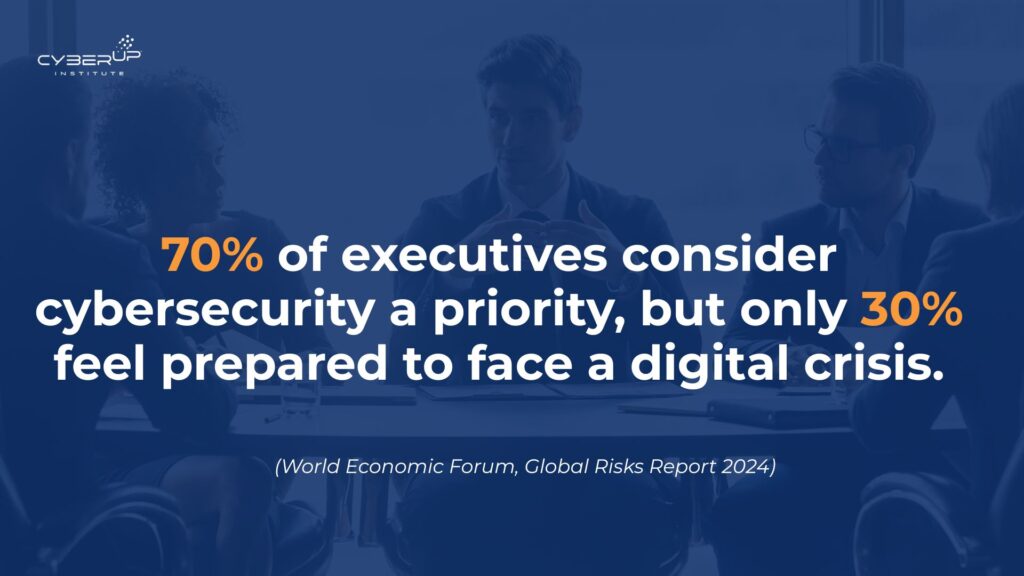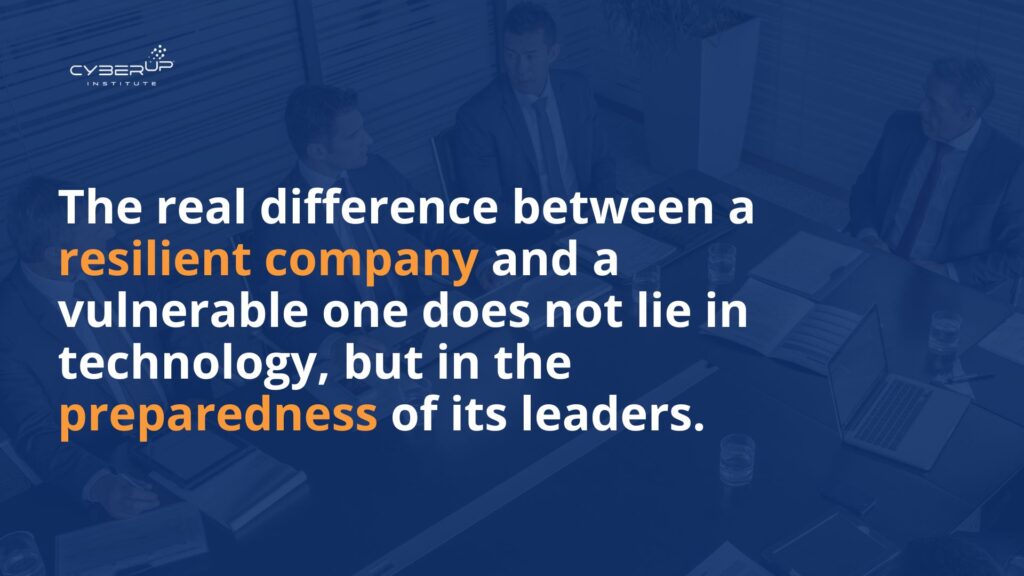In today’s digital landscape, cybersecurity is no longer the exclusive domain of IT departments but a strategic pillar of corporate governance.
Index
ToggleCyber threats directly impact the reputation, business continuity, and economic value of businesses.

In this scenario, senior management training becomes a strategic lever for anticipating risks, coordinating responses, and fostering a resilient corporate culture. CyberUP Institute offers four programs specifically designed for executives, directors, and department heads courses that combine strategic vision operational simulations and practical decision-making tools
Training as a tool for digital risk governance
The growing complexity of cyber threats—from generative AI to targeted ransomware—requires executives to take an integrated view of security Delegating isn’t enough: understanding the principles governing cyber risk is essential to managing it effectively.
Research conducted by EY Global Cybersecurity Leadership Insights 2024 highlights that companies with cybersecurity-trained leadership reduce the average response time to an incident by 42% and achieve a 30% reduction in post-attack operating costs.
CyberUP Institute responds to this need with an advanced training program structured around four complementary areas of expertise.
1. Cyber Strategy for Executives
In a context where cyber risk is now a strategic variable, every effective security strategy starts with leadership
Cyber Strategy for Executives course is designed to provide executives with the tools they need to integrate cybersecurity into corporate planning governance processes, and long-term business decisions.
Based on real-world simulations and international case studies the program helps leaders to:
● Assess digital risks in terms of economic, operational and reputational impact;
● Define investment priorities and performance indicators in the security field;
● Promote a shared safety culture at management and organizational levels.
Through a practical and strategic approach, the course enables managers to develop a systemic view of cyber risk an essential element today for driving digital transformation in a secure, compliant, and sustainable manner.
Thanks to this path, companies can transform security from an operational cost to a competitive advantage strengthening the trust of customers, partners and stakeholders.
2. Cyber Threats and Defense Essentials
Cyber Threats and Defense Essentials course provides executives with a clear and operational perspective on how to address the main cyber threats affecting businesses today.
No technical knowledge is required: the program is designed for those who lead teams, budgets, and strategic decisions but want a thorough understanding of how digital security works.
Through dynamic lessons and hands-on exercises, participants discover how hackers identify and exploit corporate vulnerabilities and learn to recognize the signs of an attack coordinating a timely and structured response.
The course introduces real-world tools—such as Wireshark and the Sysinternals Suite —that allow them to analyze networks, track anomalies, and improve cyber crisis management.
The course provides a pragmatic method for interpreting risks, planning defense actions, and communicating effectively with technical teams, strengthening collaboration between leadership and IT.
Benefits for the organization:
● Increases the ability to quickly identify and manage cyber incidents;
● Improves critical infrastructure protection and business continuity;
● Provides post-incident response and analysis procedures based on forensic standards;
● Reduces the financial and reputational impact of cyber attacks, such as ransomware and targeted phishing.
“The true strength of a corporate defense comes from the awareness of those who lead it.”
With Cyber Threats and Defense Essentials company leadership gains a strategic vision of cybersecurity, capable of transforming prevention into a lever of competitiveness and trust.
3. Red vs. Blue Training
Red vs. Blue Training course offers executives and business leaders a unique opportunity to experience firsthand the dynamics of a cyber attack and understand how a managerial decision can influence its outcome.
In a simulated, controlled environment, participants observe two teams at work:
● The Red Team which plays the role of the attackers and uses real intrusion testing techniques;
● The Blue Team tasked with detecting, containing and countering the attack.
Through this immersive experience, executives learn to recognize critical points of corporate defense understand the importance of cross-functional coordination, and experience the impact of decisions in crisis situations.
The course combines theory, simulation, and post-exercise analysis, offering a concrete insight into the logic that drives both attackers and defenders.
This path goes beyond traditional training and becomes an experiential training ground for cyber leadership
Benefits for the organization:
● Improves detection of APT and ransomware attacks
● Strengthen security with Red and Blue Team strategies
● Optimize compliance through guided hands-on exercises
● Reduce risks with rapid responses to threats
With Red vs Blue Training safety becomes tangible: company leadership gains awareness, preparedness, and the ability to lead in high-pressure situations—essential qualities for a truly resilient enterprise.
4. Cyber Crisis Management
Cyber Crisis Management course was created to train managers who, in the most critical moments, must be able to lead the organization’s response to a cyber attack with clarity and competence.
When a company suffers a complex breach or sustained attack, decisions made in the first few minutes can make the difference between controlled damage and a systemic crisis.
This course emphasizes speed and effectiveness in the decision-making process providing participants with practical tools to coordinate actions, resources, and communication in a coherent and strategic manner.
real-world case studies and immersive simulations executives learn how to structure a crisis management plan, identify operational priorities, and engage with internal and external stakeholders while maintaining transparency and control.
The route allows you to:
● Consolidate knowledge of the fundamental principles of cybersecurity and crisis management logic;
● Develop the ability to predict, address and mitigate the effects of a cyber attack;
● Exercise decision making in high-pressure contexts;
● Strengthen strategic leadership in business continuity protection.
Cyber Crisis Management represents an essential step for all leaders who want to transform the crisis experience into an opportunity for organizational growth, promoting a corporate culture based on resilience, preparedness, and digital responsibility
A comprehensive roadmap for cyber leadership
These four paths make up a true Executive Path in Cybersecurity an itinerary that transforms awareness into decision-making skills, following the sequence
Strategy → Threats → Simulation → Crisis
Organizations that train their cyber leadership gain:
● Faster response to incidents;
● More effective cross-functional coordination;
● Trust of customers, partners and investors;
● Compliance with European standards
The value for the organization
Leadership trained in cybersecurity generates measurable benefits:
● Reduction of incident response times;
● Improved cross-functional coordination during emergencies;
● Greater trust from customers, partners and investors;
● Alignment with European regulations.

Why Choose CyberUP Institute
CyberUP Institute stands out for its executive-first approach combining practical experience, academic methodology, and operational skills developed in real-world settings. Programs are developed in collaboration with industry experts, government agencies, and leading companies, ensuring ongoing training and full compliance with European regulations.
All courses are available in blended learning mode (in the classroom, online, or through interactive simulations) and can be customized based on your company profile and cyber maturity level.
Conclusion
Cybersecurity is no longer a purely technical issue, but a leadership skill Executives who understand the language, dynamics, and risks of cybersecurity are now able to make faster, more coordinated, and sustainable decisions.
With CyberUP Institute’s training programs—which combine strategy, practice, and a systemic vision—security becomes an integral part of corporate culture and competitive advantage.
Investing in cyber training for executives means investing in the continuity and reputation of the company Digital resilience begins with the people who lead it.
FAQ
1. Who are these executive cybersecurity courses for? The courses are designed for CEOs, COOs, CFOs, department heads, board members, and executives who wish to gain a strategic understanding of cyber risk and cyber governance processes.
2. Is prior technical knowledge required? No. The programs are designed for non-technical managers. Technical topics are explained in an accessible way and linked to their economic, legal, and reputational impacts.
3. How long do the training courses last? Each module has a variable duration (from 1 to 3 days) and can be followed in blended mode: in the classroom, online, or through practical simulations.
4. Can courses be customized for your company or industry? Yes. CyberUP offers personalized courses tailored to specific sectors (finance, healthcare, public administration, industry) and corporate cyber maturity levels.
5. What certifications or awards are obtained? Upon completion of the courses, a CyberUP Institute certificate is awarded, recognized nationally as an executive continuing education program in cybersecurity and risk governance.
6. How can I register or receive a personalized consultation? You can request information and book your participation directly here.
